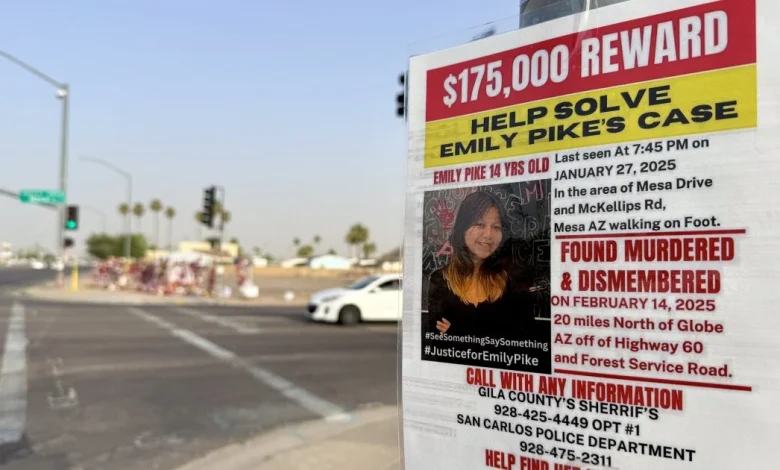Over 300 have been reported missing since launch of Turquoise Alert. Arizona used it once

We’ve probably all gotten an Amber alert to our phones when there’s been a child abduction or a Silver Alert for a missing older adult.
But, here in Arizona, we’ve only gotten one Turquoise Alert, a new kind of emergency alert designed by state lawmakers to close gaps in the system when a missing person doesn’t meet the requirements of either of those other alerts.
This happened even as nearly 300 people were reported missing in Arizona since the Turquoise Alert was launched.
The legislation was dubbed “Emily’s Law” at the state Legislature, as lawmakers cited the tragic case of Emily Pike, a member of the San Carlos Apache Tribe, who went missing from a Mesa group home earlier this year and was later found brutally murdered.
But, as Chelsea Curtis reported, even Pike’s case wouldn’t qualify for a Turquoise Alert. Curtis is a reporter for Arizona Luminaria who covers missing and murdered Indigenous People in the state.
Amber Victoria Singer/KJZZ
Chelsea Curtis in the KJZZ studio in April 2024.
Full conversation
LAUREN GILGER: Good morning, Chelsea, welcome back to The Show.
CHELSEA CURTIS: Good morning. Thank you for having me.
GILGER: Thanks for coming in. So tell us first just what this Turquoise Alert was supposed to do. Who’s it supposed to be for?
CURTIS: Yeah. So initially, when the measure was proposed in the Legislature, it was proposed as an alert specifically for Indigenous people because Indigenous people historically have faced high rates of violence and number of disappearances, and so this was meant to address that. And, eventually, it was amended. It was amended to include everybody, so not just Indigenous people, and then to have an age limit of 18 to 64.
And at the time they started, lawmakers promoting the measure started tying Emily Pike’s case to this as an example of one they hope to prevent in the future with this bill and this alert. But I recognize that Emily Pike is 14, and the age parameters were 18 to 64 — so that automatically would have disqualified her from having this alert.
GILGER: Right.
CURTIS: And when I spoke with Representative Teresa Martinez about this, she wound up making a change to that and changing the age limit to all minors up to 64. But again, it still begged the question of, you know, if Emily would have still qualified for this alert, because her case wasn’t deemed suspicious. She was labeled a runaway.
GILGER: Right.
CURTIS: And there wasn’t a factor of danger, according to the missing persons report.
GILGER: Right, which is all kind of in the specific criteria that the alert requires in the legislation. There’s a difference here, it sounds like, between a runaway, as Emily Pike was labeled, and a missing person. But you report that there are a growing number of experts who kind of say that anybody under the age of 18 who goes missing should be considered, you know, endangered.
CURTIS: Yes, yes. According to my research through this, yeah, there are a growing number of experts that do say that any missing child is a child in danger. And not only that, but a lot of children who are runaway are more prone to getting into dangerous situations, and so, if anything, they’re more at risk.
GILGER: Yeah. OK. So let’s talk about the fact that it’s only been used once since July. The Department of Public Safety told you this is by design.
CURTIS: Yes, yes, they said that it is by design, that they are following the law, and the law requires that all of the criteria be met, which is that, first, there’s a report filed with law enforcement databases, the person is under 65, there’s an element of suspicious circumstance, unexplained circumstance, and, you know, the danger factor.
GILGER: Yeah.
CURTIS: And so they say that, you know, there’s nearly 300 people in Arizona missing since July, since this launched, and they say none of them met all of those criteria. So they say they’re following the law, that it’s working as designed, and that filing or putting out an alert for every single case would likely desensitize the public.
GILGER: Sure. Yeah. A fair argument to make. How does all of this relate to tackling the epidemic in this country of missing and murdered Indigenous people, which you’ve covered for so long? Chelsea, like, we know that Indigenous children go missing at much higher rates. Is this addressing that problem from your reporting?
CURTIS: Just based on my reporting? No. It, you know, raises the question of, you know, if this was the alert that was supposed to help a lot of these children who are going missing by bringing attention to their case a lot sooner and helping locate them a lot sooner — but it’s only been used once — then, you know, how is it helping? And would people like Emily, children like Emily — is that still happening? And what is the answer?
GILGER: Yeah. OK. Are law enforcement officers trained in how to use this alert?
CURTIS: Yes. DPS (Department of Public Safety) did tell me that they have done several outreach sessions, some virtual sessions with law enforcement across the state — not only on the Turquoise Alert, but their alert systems in general — just to tell them, you know, the criteria for all of them, and how to submit a request to their office, which is, like, a packet with all of the information, and they then put it through a rigorous review process and, from there, make a determination. But they are doing outreach, they say that continues.
GILGER: Yeah. OK, so just going forward, then, in the last minute or so here, Chelsea. Tell us, like, where you think this leaves us. Like, is this kind of alert — or what else might be needed, I guess, to try to tackle this issue that continues where Indigenous children are still going missing at such disproportionate rates.
CURTIS: Yeah, that’s actually what I’m working to answer right now, looking for some experts to maybe shed some light onto this. My initial research is pointing to more investment in resources that sort of try to prevent this from happening from the beginning, whether that’s, you know, more family assistance or counseling. Although again, super early stages of what exactly that looks like.
GILGER: Yeah. OK. So it sounds like lots still to watch for here.
CURTIS: Yeah. Yeah, for sure.
KJZZ’s The Show transcripts are created on deadline. This text is edited for length and clarity, and may not be in its final form. The authoritative record of KJZZ’s programming is the audio record.
-
Last summer, KJZZ’s Sam Dingman drove up to Flagstaff to meet singer-songwriter Sage Bond. Bond had just graduated from NAU a few weeks earlier. She showed up wearing all black. She had long black hair, and she was carrying a black guitar case, containing a black acoustic guitar.
-
An Oct. 16 release from DHS announces non-US citizens who are crossing the border at ports of entry will now be subject to a $1,000 fee for entering the U.S. using parole.
-
After mining industry trade groups sued to overturn the rule, federal judges twice paused its enforcement before the government shutdown delayed it a third time this month. Andy Martin went to the Department of Labor to speak out against further delays.
-
The 14,000-square-foot supermarket nestled in the heart of Sacaton is much more than a store. It’s a symbol of their sovereignty since few, if any, tribes outright own their own grocers.
-
The New York Mavericks franchise typically extends a dozen or so invites, but is guaranteeing one spot on its training camp roster for the reigning INFR world titleholder. It’s a change the PBR made last year.
Load More





